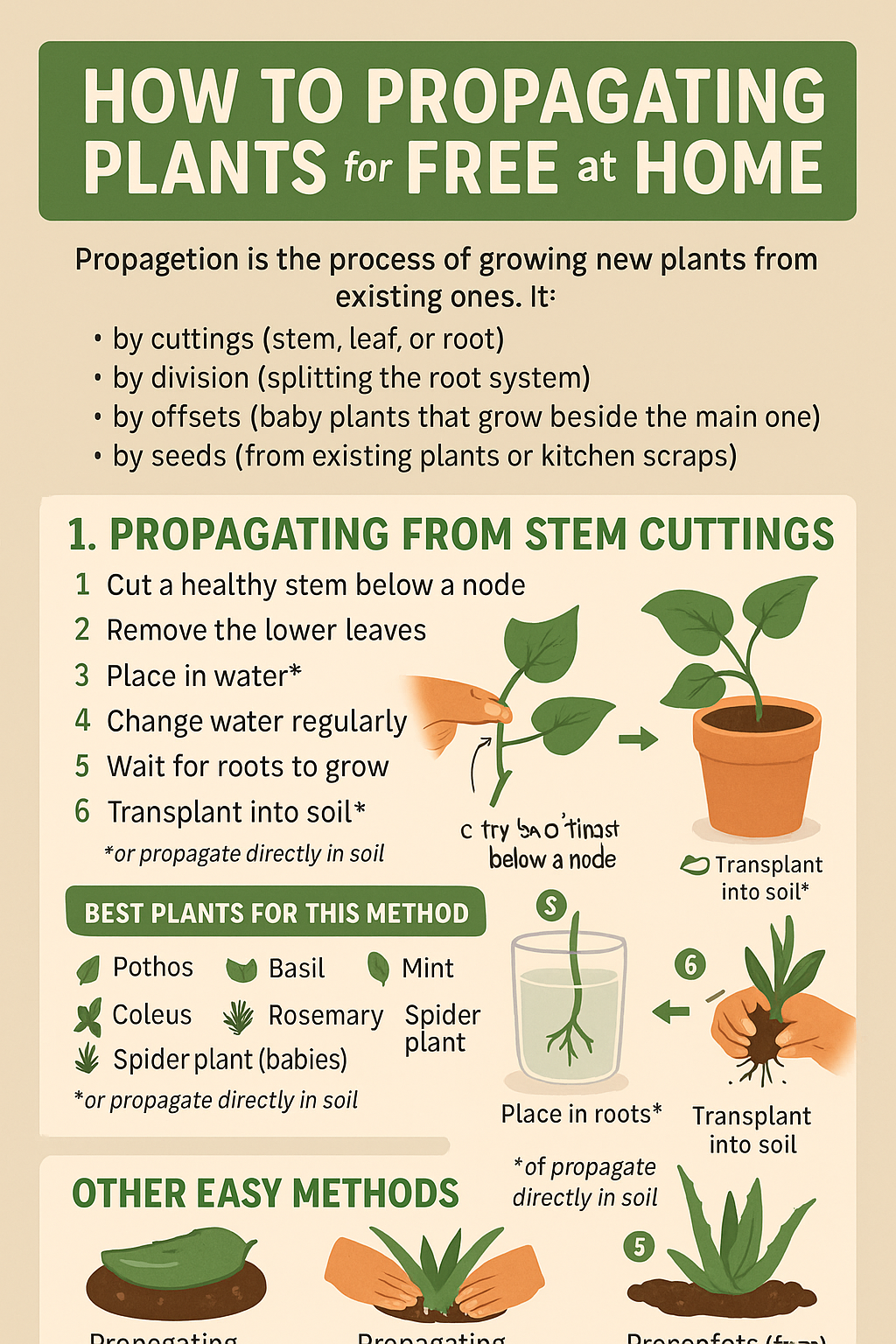Growing your plant collection doesn’t have to cost a thing. With plant propagation, you can multiply your favorite greenery using cuttings, leaves, seeds, or even roots — all without buying anything new. Whether you want more herbs in your kitchen, succulents on your shelf, or flowers on your balcony, propagation is the ultimate budget-friendly gardening hack.
In this guide, you’ll learn the easiest and most effective ways to propagate plants at home, using common tools and techniques suitable for beginners.
What Is Plant Propagation?
Propagation is the process of growing new plants from existing ones. It’s like plant cloning — you take a part of the parent plant (like a leaf or stem), and under the right conditions, it grows into a new, independent plant.
There are several ways to propagate plants:
- By cuttings (stem, leaf, or root)
- By division (splitting the root system)
- By offsets (baby plants that grow beside the main one)
- By seeds (from existing plants or kitchen scraps)
The method you use depends on the type of plant you’re working with.
Why Propagate Plants at Home?
- It’s completely free: No need to buy new plants.
- It reduces waste: Use cuttings from pruned or trimmed plants.
- It’s satisfying: Watch something grow from scratch with your own care.
- It creates gifts: Share plants with friends, family, or neighbors.
- It teaches patience and observation: A great way to learn gardening skills.
Tools You’ll Need (Most Already at Home)
- Clean scissors or a sharp knife
- Small containers (jars, cups, bottles, egg cartons)
- Water
- Potting soil or compost
- Spray bottle (optional)
- Plastic bag or wrap (for humidity)
Tip: Always clean your tools to prevent spreading disease between plants.
1. Propagating From Stem Cuttings (Most Common Method)
This is one of the easiest and fastest ways to grow new plants. Many herbs and houseplants root well from a simple stem cutting.
Steps:
- Cut a healthy stem about 10–15 cm (4–6 inches) long just below a leaf node.
- Remove the bottom leaves to expose the node.
- Place in water (preferably in a clear glass near light but not direct sun).
- Change water every few days to prevent rot.
- Wait for roots to grow (this can take 1–4 weeks).
- Transplant into soil once roots are 2–5 cm (1–2 inches) long.
Best Plants for This Method:
- Pothos
- Basil
- Mint
- Coleus
- Rosemary
- Spider plant (babies)
2. Propagating From Leaf Cuttings
Some plants grow well from a single leaf, especially succulents.
Steps:
- Gently twist off a healthy leaf near the stem.
- Let the leaf dry out for 1–2 days (important for succulents to avoid rot).
- Place the leaf on top of moist soil, or insert the tip slightly.
- Mist with water and keep in bright, indirect light.
- Tiny roots and new leaves will begin to grow at the base.
Best Plants for This Method:
- Echeveria
- Jade plant
- Snake plant (Sansevieria)
- African violets
3. Propagating By Division
This method works well with plants that form clumps, like herbs, ferns, or ornamental grasses.
Steps:
- Remove the plant from its pot or soil gently.
- Use your hands or a knife to separate the root ball into smaller sections.
- Make sure each section has roots and leaves.
- Replant each piece in its own container or space.
Best Plants for This Method:
- Aloe vera
- Spider plant
- Mint
- Hostas
- Snake plant
4. Propagating From Offsets (Pups)
Some plants naturally produce small versions of themselves around their base — these are called offsets or pups.
Steps:
- Wait until the pup is at least 1/3 the size of the parent.
- Gently cut or pull away from the base, including some roots if possible.
- Let it dry for a day if it’s a succulent.
- Plant in soil and water lightly.
Best Plants for This Method:
- Aloe vera
- Succulents (like hens and chicks)
- Bromeliads
- Banana plants
5. Propagating From Kitchen Scraps (Bonus Method)
You can grow plants from leftover food scraps — a super budget-friendly option.
Try This:
- Green onions: Place white root ends in a glass of water. They regrow in days.
- Lettuce or celery: Place the base in water and wait for new leaves.
- Potatoes or garlic: Plant sprouting pieces in soil.
- Tomato seeds: Dry seeds from ripe tomatoes and plant in soil.
This is great for edible gardening and makes full use of what you already have.
Tips for Successful Propagation
- Use indirect sunlight: Direct sun may scorch new growth.
- Keep humidity high: Cover with a plastic bag or use a mini greenhouse setup.
- Be patient: Some plants take weeks to root.
- Label your cuttings: If propagating many plants, it helps to keep track.
- Water gently: Especially after transplanting to soil.
Signs Your Propagation Is Working
✅ Roots are forming
✅ New leaves appear
✅ No signs of mold, rot, or drooping
✅ The cutting remains green and firm
If your cutting turns black or mushy, discard and try again — some failure is part of the process!
Final Thoughts: Growing More with Less
Propagating plants is one of the most rewarding, sustainable, and cost-effective gardening skills you can learn. Whether you’re expanding your collection, sharing with others, or simply exploring a new hobby, it brings the joy of new life — all starting from what you already have.
And remember: you don’t need to be a gardening expert. All it takes is a little patience, observation, and care.
